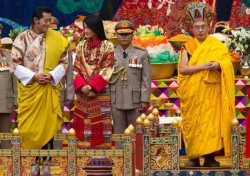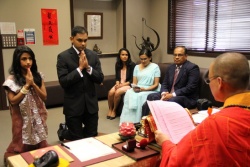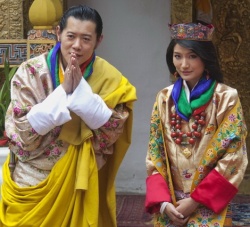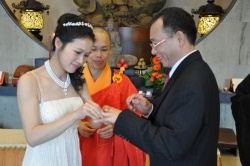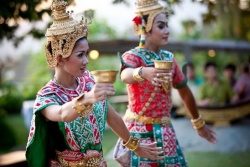How to Plan a Buddhist Wedding
Visit a lama, or a Buddhist priest, who can help the groom determine whether your horoscopes are matched and compatible for marriage. After matching horoscopes the groom along with his family consults the lama for assistance in selecting a spiritually-sound day for proposing marriage to the bride.
Celebrate the coming wedding with Chessian, a traditional betrothal ceremony. In this ceremony, the maternal uncle of the bride sits on a platform while the lama gives a prayer and shares Madyan with the guests, a traditional religious drink. Following Chessian the lama is consulted once again to find an astrologically-sound date for the wedding day.
Decide where to hold the wedding. Traditionally, Buddhist wedding ceremonies are small events that include only close friends and family. It is most common to hold the ceremony in the bride's home; however more often ceremonies are being celebrated in temples to accommodate more guests.
Arrive at the temple or bride's home early on the day of the wedding in order to prepare a marital shrine honoring Lord Buddha. The groom will bring the bride's dowry, which will accompany the image of Buddha and will create the shrine's decoration. The dowry should include either six or nine (seven and eight are considered unlucky) trays holding incense, fruit, tea, cake, meat and jewelry. One of the trays should hold two candles which each of you will light during the ceremony as a symbol of the union of your families.
Begin the ceremony by lighting the candles and incense placed in front of the shrine to Buddha and offering flowers. It is traditional that the ceremony begins with the hymns Vandana, Pancasila and Tisarana.
Recite the Buddhist wedding vows as inscribed in the Sigilovdda Sutta. The groom will say, "Towards my wife I undertake to love and respect her, be kind and considerate, be faithful, delegate domestic management and present gifts to please her." The bride will then say, "Towards my husband I undertake to perform my household duties efficiently, be hospitable to my in-laws and friends of my husband, be faithful, protect and invest our earnings and discharge my responsibilities lovingly and fastidiously."
Conclude the Buddhist wedding ceremony by reciting blessings for the newlyweds. The most common are the Magnal Sutta and the Jayamangala Gatha.
The weddings of Buddhist couples are simple occasions, enjoyed by the friends and family who unite to rejoice in the extraordinary joining together of husband and wife. Because very few Buddhist temples are legally allowed to perform a marriage ceremony, this part of the day is often conducted in the home or garden of a close relative. Once legally married, the bridal couple will continue to a Buddhist temple, where they will receive the blessings of a monk. Many modern couples are not living near a genuine Buddhist temple. These ones have had to erect a shrine in another location and use this for the prayers and blessings instead. Part of this ceremony involves giving food, flowers, candles, and so on as gifts for the monk. They also present prayers to the Almighty and to Buddha.
Prior to the wedding, the groom’s family frequently bring trays of flowers, fruit and wine to the temple. They will also usually bring candles to the temple, which will be lit by the bride and groom to symbolise their new state of unity. Six and nine are considered to be lucky numbers. Therefore, these are usually the number of trays brought to the temple.
The dress of the bride, groom and their wedding guests is formal and conservative to show respect for the religious standards and expectations. The bridal couple traditionally wears colourful meditation robes that have been embroidered and embellished in exquisite detail. Colours like red, orange, pink and burgundy are popular. Some couples, particularly modern ones, opt for a more typical white gown. Because of the progressive times, this is starting to become more acceptable to the Buddhist communities. No shoes are worn in the temple by either the couple or their guests.
The marriage vows are quite different from those said in Christian weddings, but still hold the same commitments to love, respect and protect one another. The husband also promises to give pleasing gifts to his wife and she vows to be hospitable and welcoming to his family and friends.
After the formal ceremony, the couple and their guests proceed to the reception, which is a big celebration with great food, and plenty of singing and dancing. Buddhists are, traditionally, vegetarian or vegan (which excludes all animal products) and the wedding food is likely to adhere to these requirements.
Buddhist adherents can marry someone of any religion, as long as their new partner supports their love for Buddha, understanding its importance in his or her life. The customs of a Buddhist wedding are not as focussed on religion and faith as other wedding ceremonies, and are more about celebrating a happy, mutually respectful relationship. The ceremony and traditions around the marriage are, therefore, centered on the preferences of the couple’s respective families, and not on a religious set of strict requirements.
A Buddhist wedding is one of the simplest, but also the most special of all, as they are all about love and commitment.
